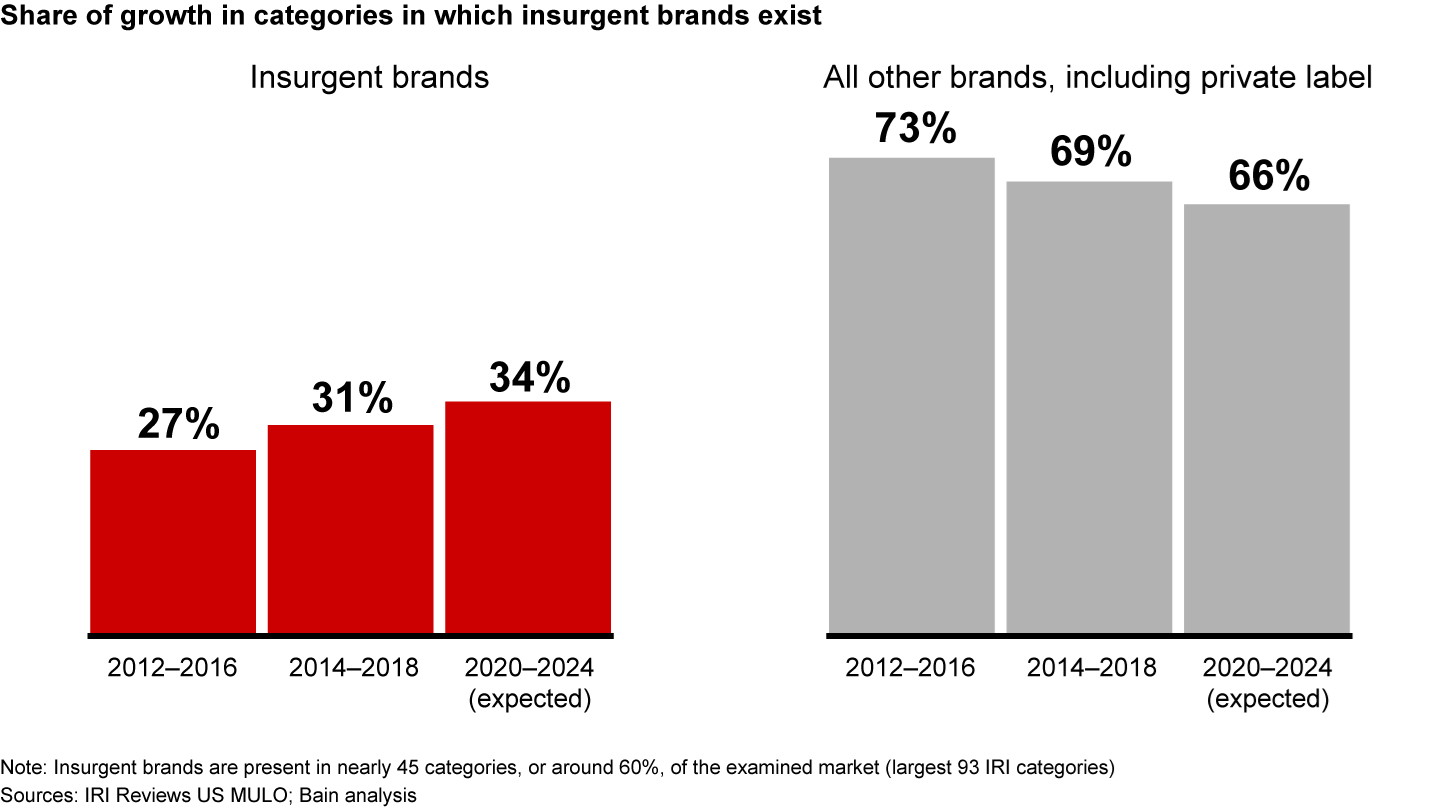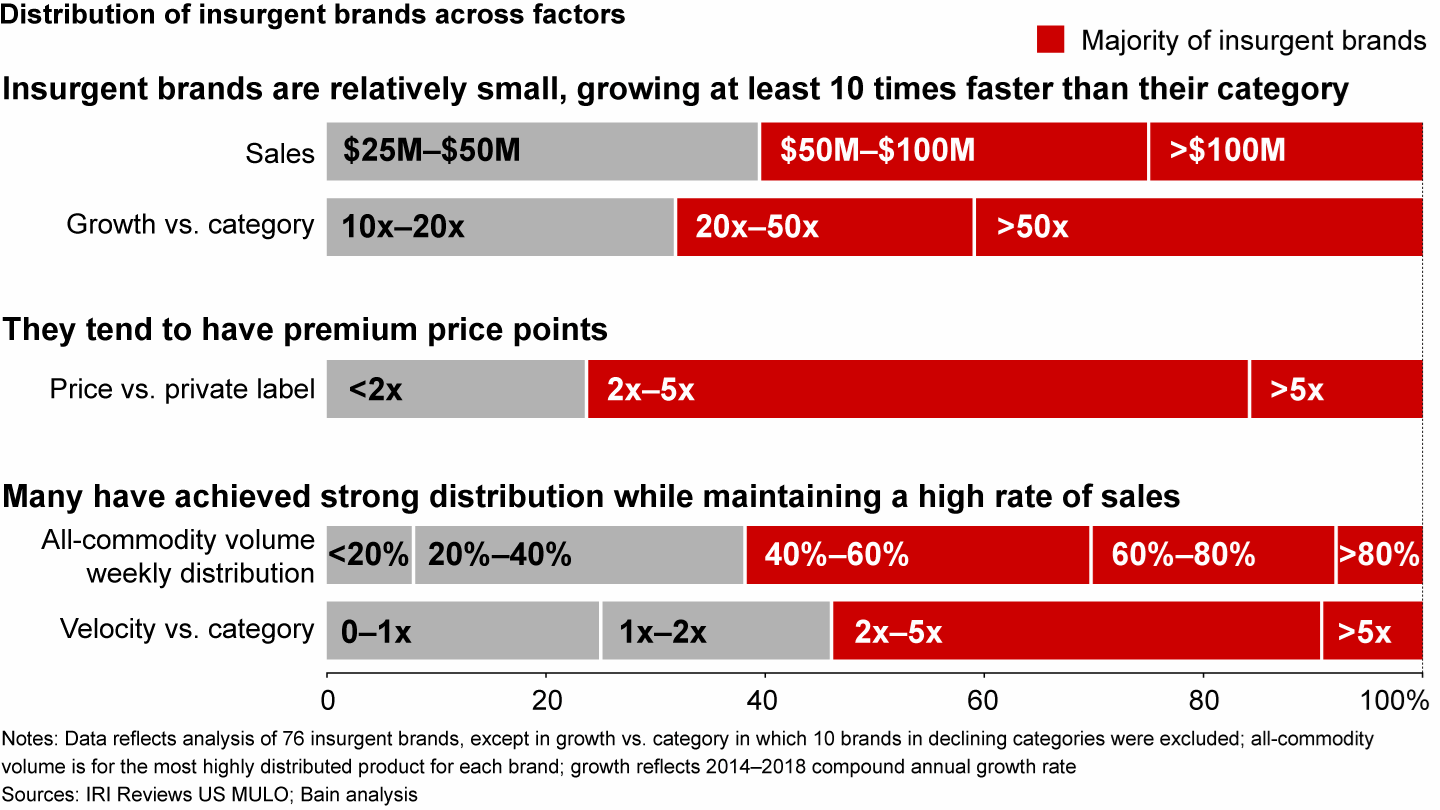Brief

Auf einen Blick
- Insurgent brands will continue to capture a significant share of growth in consumer products—35% by 2025 across the categories that they’ve disrupted. With lower barriers to entry and cost of innovating, insurgents are here to stay.
- To compete, incumbents cannot continue running their businesses as they have for decades. Yet incumbents cannot simply try to replicate the insurgents’ model for success.
- The most successful incumbents will rededicate themselves to a purpose-driven consumer focus, rethinking their portfolio strategy as they develop Agile ways of working, asset-light business models and a repeatable model for M&A.
While there may be no end in sight to the insurgent brands invasion, signs of hope are on the horizon for the large, established consumer goods companies that have been battling insurgents in the war for growth.
The numbers tell the story. We define insurgents as brands with at least $25 million in sales and that are growing by at least 10 times their category rate over the past five years. Last year, our research found that these brands accounted for less than 2% of the market share across the 45 categories that they have disrupted but that they had captured around 25% of the growth from 2012 to 2016. Two years later, insurgent brands’ share of growth had increased to around 30% of the growth from 2014 to 2018. Our research suggests that their market share will stabilize at 35% by 2025 (see Figure 1).
Insurgent brands continue to capture an outsized share of growth


Our findings offer a double dose of hope for large consumer products companies. It means that industry growth prospects are more promising than many big companies may have believed—when a brand serves its consumers well, they buy. It also means that a blueprint for growth exists as insurgent brands provide continuing lessons to the broader industry in Agile ways of working, asset-light business models and purpose-driven consumer focus. Among billion-dollar consumer goods companies, those that incorporate those lessons will be in a better position to outpace competitors.

Lessons in Growth from Insurgent Brands
Large consumer product companies can take valuable insights from fast-growing brands that are shaking up the market.
What we’ve learned about insurgents
There’s no question that insurgent brands are here to stay. The barriers to entry and the cost of launching a new brand have never been lower. We found them in roughly half of the 90 categories we analyzed—large and small categories, fragmented and consolidated categories, high-growth and low-growth categories. And they keep coming. New entrants, such as Not Your Mother’s cosmetics and Beyond Meat, are joining their more established counterparts, such as Justin’s and Harry’s, and making gains with natural ingredients, functional benefits and new formats, which reflects high levels of innovation, even in previously disrupted categories.
In fact, 41% of the insurgent brands that we identified in 2018 are new to the list. Meanwhile, many brands that were previously on our list but no longer meet the insurgent brands’ growth criteria continue to do well, just at lower levels of relative growth. Sustaining growth at 10 times the category rate is difficult to achieve. Most incumbents would be happy to grow at a fraction of that rate.
The more we see insurgents gaining ground, the clearer their path to brand growth comes into focus. In some ways, they represent a return to basics for brands—namely, being close to consumers and creating unique offerings that meet consumer needs. At large companies, the combination of scale, cost pressures and bureaucracy have made it difficult to maintain a single-minded focus on the consumer.
Most rising insurgent brands come with an authentic, passionate and personal story in which the brand addresses a specific unmet consumer need. For Zevia CEO Paddy Spence, it was about eliminating sugar from his diet. For Caulipower founder Gail Becker, it was the lack of gluten-free food options for her children. These compelling value propositions often allow insurgents to price at a premium.
Insurgent brands achieve early growth primarily through distribution, using effective digital marketing tools to target relevant audiences and maintain strong velocity levels (see Figure 2). Their Agile and asset-light operating model allows them to test and learn as they grow, relying on an ecosystem of partnerships that give them the flexibility to adapt along the way (see the Bain Brief “How Insurgent Brands Are Rewriting the Growth Playbook”).
Insurgent brands are often premium brands with higher velocity levels


The best-performing insurgents not only grow distribution but also do so while sustaining velocity via targeted and then scale marketing as they expand their reach. In fact, we found that the brands that were able to maintain their rate of sales while expanding the breadth of their distribution demonstrated the ability to appeal to broader and broader audiences, which enabled them to achieve growth rates four times greater in later years than those brands in which distribution growth outpaced velocity.
These winning insurgents also concentrate on their most successful products. Insurgents that focus on driving core hero SKUs to full distribution during their expansion phase outperform during the mature phase compared with those that proliferated their SKUs earlier on. BodyArmor reached close to 70% all-commodity volume before introducing new SKUs, and it is now among the companies that defied the odds and continues to meet the high bar that defines insurgents, outpacing growth tenfold or more, even after reaching scale distribution.
If incumbents have learned anything from insurgents, it is that they cannot continue running their businesses as they have for decades. Yet incumbents cannot simply try to replicate the insurgents’ model for success. Instead, large consumer goods companies need to create a hybrid model that maintains the economics of their existing brands while they develop new approaches that embed insurgent learnings. That will mean focusing on four areas.
Rediscover the consumer. Among the hallmarks of insurgents is their ability to deliver authentic, purpose-driven brands that serve an unmet consumer need and to maintain a strong and consistent connection with those consumers. Some large consumer goods companies are starting to put the consumer back in the center. Danone’s manifesto to improve people’s health and protect the planet has been adopted by 40 of its brands—brands that are now growing three times faster than the rest of Danone’s portfolio. Unilever is getting closer to its consumers by using artificial intelligence in the 27 data centers it maintains across the globe to synthesize and act on consumer insights from a range of sources, including social listening, customer relationship management and traditional marketing research.
Rethink brand portfolio strategy. Winning incumbents take a holistic approach to brand portfolio strategy, balancing brands of different sizes in order to meet the future needs of their consumers. For Mondelēz, steady insurgent growth and changing consumer needs has meant managing a more diverse portfolio of products, each with different strategic roles. Global power brands, which comprise 43% of its revenue, help it sustain category leadership, while local jewels, which generate 47% of revenue, are focused on meeting local consumer preferences. Meanwhile, its innovation brands evolve with consumer trends. Brand owners will need to be extremely clear on the different roles each of these brands play, what flexibility they have and what their growth ambitions should be.
Build repeatable M&A capabilities. Increasingly, large consumer goods companies are turning to M&A to acquire insurgent brands. Acquisitions help incumbents create faster-growing portfolios that leverage scale and breadth of distribution to further grow the insurgent, potentially taking the insurgent brand into other categories or markets. As demonstrated by Bain’s long-term research into M&A performance, the best companies will develop repeatable capabilities for M&A success (see the Bain Brief “New Rules for M&A in Consumer Products”).
To ensure positive outcomes, acquirers need to be able to articulate why they are the appropriate parent for a particular insurgent brand. What are the incremental and scalable capabilities that can accelerate the target’s growth trajectory? As these acquirers are learning, scope deals, such as those involving the acquisition of insurgent brands, can be hard to get right. Scope deals are more expensive because of higher deal multiples that reflect the superior growth profile of the target assets. They call for new approaches to diligence that rely on more forward-looking assessments of revenue synergies and future value. They also require different approaches to integration to ensure that the acquirer does not crush the acquired asset under its existing weight, suffocating the very culture that led to the acquired brand’s growth.
Create nimble ways of working. Finally, incumbents need to change their ways of working to be faster and more Agile, they need to accelerate test-and-learn capabilities, and they need to do this across and throughout a billion-dollar corporation. The scope of the challenge is something that cannot be underestimated. Insurgents started small and Agile. But the big task at hand is to take something that is massive, with well-honed structures and processes to manage risk and exert control, and give it a different set of rules—for example, less frequent financial reviews or faster approval processes. Some established companies are successfully embedding Agile in product development and innovation to rapidly test and iterate, as well as leverage partners to improve flexibility and speed. For example, Clorox has used such methods to reduce the time it takes to innovate a new product by 40%.
New portfolio dynamics require an adaptable operating model. Billion-dollar brands and $25 million brands are different animals; however, both need to have the governance, decision-making processes, organizational structures and incentives that make them nimble.
Given the low barriers and low cost to build brands and bring products to market, insurgent brands are here to stay. There will continue to be insurgents looking to capture growth by relentlessly upping the game, meeting consumer needs. Incumbents that learn from these insurgents and respond by focusing on these four areas can capture and generate their own growth, creating the consumer products company of the future. The more that incumbents can learn from insurgents, the less they have to fear.
Brian McRoskey and John Blasberg are Bain & Company partners with the firm’s Consumer Products practice, and they are based in Boston. Charlotte Apps is a Consumer Products practice director based in Toronto.
The authors would like to thank Joe Kiernan, Gregorio Colaci and Kevin Sani for their contributions to this work.